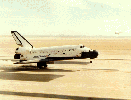


 Launch
LaunchNASA's re-useable space vehicle, the Space Shuttle, takes off like a rocket, operates in orbit like a spacecraft, then lands like an aircraft. Here it lifts off the launchpad at Kennedy Space Center near Orlando, Florida. At this moment five rockets are firing: the Shuttle's three main engines and two solid rocket boosters. Together they are generating almost seven million pounds of thrust at the moment of lift-off.
 SRB Burn
SRB BurnAfter lift-off, the solid rocket boosters attached to the sides of the large, reddish, external fuel tank continue to burn for approximately 2 minutes. When their fuel is spent, they separate from the tank, fall back into the sea, and are retrieved for re-use on subsequent Shuttle missions. The Shuttle's three main engines continue to fire, using half a million gallons of liquid hydrogen and liquid oxygen. Between 8 and 9 minutes into the flight Earth orbit is achieved, the external tank is cast away, and the astronauts use small maneuvering engines to ease the Shuttle into its final orbit.
 Cargo Bay
Cargo BayIn this image, a space-suited astronaut prepares a satellite for its release from the Shuttle's cargo bay. The bay, 18.3 m long and 4.6 m wide (60 ft by 15 ft), has payload attachment points along its full length, and is adaptable enough to accommodate as many as five unmanned spacecraft of various sizes and shapes in one mission. The cargo bay is equipped also with a 15 m (50 ft) robot arm for lifting and releasing, or grasping and retrieving satellites in space.
 Touchdown
TouchdownThe return to Earth at the end of a mission is a critical and demanding time for the Shuttle crew. Astronauts slow the craft and ease it into Earth's atmosphere by using small rockets in the craft's nose and tail. Then after re-entry, they steer it like an airplane using rudders and flaps as the craft glides Earthward. Here, after having slowed down from 1000 to 100 meters per second, and withstood temperatures of up to 1000 degrees Centigrade, the Space Shuttle Columbia touches down at Edwards Air Force Base, thirty busy minutes after having left Earth orbit.
 Return to Kennedy
Return to KennedyIdeally, each Space Shuttle mission ends with a landing at the Kennedy Space Center in Florida. However, when weather conditions are unfavorable there, mission controllers direct the Shuttle to land on a dry, desert lake bed Edwards Air Force Base in Southern California. On these occasions, the Shuttle gets a ride back to Kennedy atop a Boeing 747. After its return to Kennedy, the Shuttle will be ready to fly again in two weeks' time.
